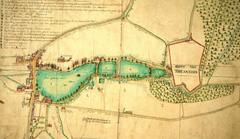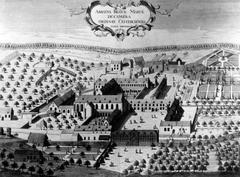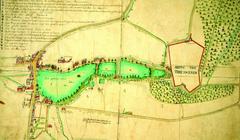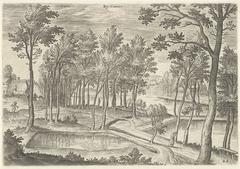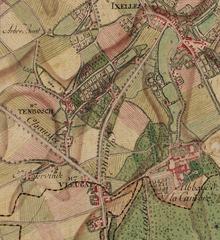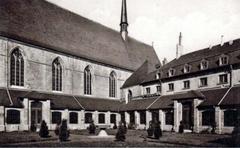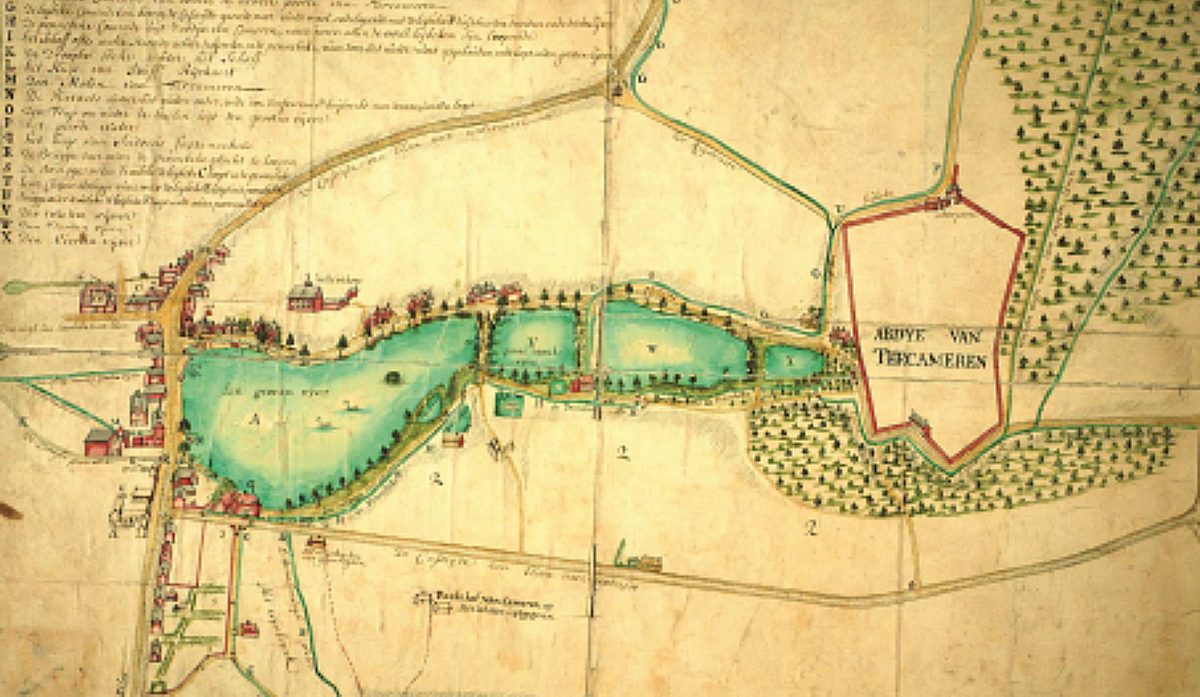
La Cambre Abbey: Visiting Hours, Tickets, and the Ultimate Guide to Brussels’ Historic Gem
Date: 14/06/2025
Introduction: La Cambre Abbey’s Timeless Allure
La Cambre Abbey (Abbaye de la Cambre), set in the lush Maelbeek valley of Brussels’ Ixelles district, stands as a living chronicle of the city’s medieval origins, architectural evolution, and dynamic cultural present. Founded as a Cistercian convent in 1196, the abbey has grown from a secluded sanctuary into a vibrant hub for the arts, education, and community life. Its captivating blend of Gothic, Renaissance, and Baroque architecture, paired with tranquil formal gardens, invites visitors to experience a unique intersection of history, spirituality, and creativity (ARAU; Inside Brussels; ReflexCity).
Contents
- Origins and Foundation
- Medieval Growth and Religious Importance
- Architectural Evolution
- Medieval Cistercian Roots
- Renaissance & 18th-Century Expansion
- Modern Restorations
- Transformations through the Centuries
- Preservation and Modern Use
- Visiting La Cambre Abbey: Essential Information
- Hours & Admission
- Guided Tours
- Accessibility
- Directions
- Key Features and Artistic Highlights
- Gardens and Outdoor Spaces
- FAQs
- Planning Your Visit
- Sources
Origins and Foundation
La Cambre Abbey was established at the close of the 12th century by Gisèle, a noblewoman, as a Cistercian convent for women. The order’s emphasis on simplicity, prayer, and work shaped both the architecture and daily life. The Maelbeek valley’s seclusion provided the ideal setting for monastic contemplation and self-sufficiency (ARAU).
Medieval Growth and Religious Importance
During the 13th and 14th centuries, the abbey flourished as a spiritual beacon. Its church, dedicated to the Blessed Virgin Mary, became a pilgrimage site, attracting notable figures like St. Boniface of Brussels, who died there in 1260 (Saintly Ways). The nuns managed extensive lands, ensuring the abbey’s economic independence, while the scriptorium contributed to the preservation of religious texts.
Architectural Evolution
Medieval Cistercian Roots
La Cambre’s earliest buildings reflected the Cistercian ethos: pointed arches, ribbed vaults, and an emphasis on unadorned yet harmonious space (ReflexCity). The abbey church, with its slender columns and luminous interiors, remains a rare example of Gothic architecture in Brussels.
Renaissance & 18th-Century Expansion
The tumult of the 15th and 16th centuries—marked by wars of religion—necessitated reconstruction. Renaissance influences emerged, followed in the 18th century by Baroque and classical additions such as the Louis XV pavilion and Chapter Hall, characterized by symmetry and refined stonework (ÁRTER Architects).
Modern Restorations
After secularization during the French Revolution and subsequent decline, the 19th and 20th centuries brought significant restoration. Notably, the founding of the École nationale supérieure des arts visuels de La Cambre (ENSAV) in 1927 by Henry van de Velde marked the abbey’s transition to a center for the arts (La Cambre School). Recent projects have preserved historical integrity while adapting the site for modern use (ÁRTER Architects).
Transformations through the Centuries
From the suppression of monastic orders during the French Revolution to uses as a military hospital and poorhouse, La Cambre Abbey’s fortunes have waxed and waned. Its resilience is evident in the 20th-century revival, with restoration campaigns safeguarding its architectural and cultural legacy (ReflexCity).
Preservation and Modern Use
Today, La Cambre Abbey is a protected monument and a thriving arts campus. It houses ENSAV, hosts exhibitions and events, and remains an active parish church (La Cambre School; Saintly Ways). The abbey’s gardens are a public oasis, and its buildings serve both religious and educational purposes.
Visiting La Cambre Abbey: Essential Information
Opening Hours:
- Gardens and exterior: Daily from dawn to dusk
- Abbey church: Open for Mass and select visiting hours (check parish schedules)
- Interior buildings: Restricted, with special access during events or guided tours
Admission:
- Gardens and outdoor areas: Free
- Special exhibitions or tours: May require tickets; purchase online or on-site
Guided Tours:
- Offered during heritage days and by appointment; audio guides available for self-paced exploration
Accessibility:
- Main garden paths have ramps and are mostly accessible
- Some historic areas have steps or uneven surfaces
- Visitors with reduced mobility should contact the abbey in advance for assistance
Getting There:
- Address: Abbaye de la Cambre 11, 1000 Brussels
- Public transport: Tram lines 8, 93, 94; nearby bus routes; short walk from Place Flagey
- Parking: Limited; public transport recommended (Triphobo)
Facilities:
- Public restrooms are limited; nearby cafés provide facilities
- Seasonal outdoor bar; additional dining at Place Flagey and Avenue Louise
- Picnics permitted in the gardens
Key Features and Artistic Highlights
- Abbey Church: 14th-century Gothic structure with understated Cistercian ornamentation; houses artworks like Albert Bouts’ The Mocking of Christ (Spotting History)
- Cloister and Refectory: Peaceful quadrangle and former communal dining hall; interior access limited due to institutional use
- Chapter Hall (Aile Capitulaire): Restored for exhibitions and events (ÁRTER Architects)
- Louis XV Pavilion: Elegant 18th-century addition with symmetrical design (Inside Brussels)
- Library and Archives: Home to graphic and photographic collections, including works by Henry van de Velde (La Cambre School)
Gardens and Outdoor Spaces
Meticulously restored French formal gardens with tree-lined avenues, terraced lawns, and clipped hedges provide a tranquil escape (Inside Brussels). The gardens host seasonal events like concerts and pop-up bars (e.g., Chez Gisèle), while the “King’s Garden” commemorates 19th-century landscaping trends (Secret Attractions).
FAQs
Q: What are La Cambre Abbey’s visiting hours?
A: Gardens are open daily from dawn to dusk; church is open for Mass and select hours.
Q: Is there an entrance fee?
A: No fee for gardens and exterior; exhibitions and guided tours may require tickets.
Q: Is the abbey accessible for visitors with disabilities?
A: The main paths are accessible, though some historic areas may pose challenges.
Q: How do I get to La Cambre Abbey?
A: Use tram lines 8, 93, 94, or buses; parking is limited.
Q: Are guided tours available?
A: Yes, during heritage days and by arrangement; check official listings for details.
Q: Can I take photos in the abbey?
A: Photography is allowed in gardens and exteriors; restrictions may apply inside the church.
Planning Your Visit
- Best Time to Visit: Late spring through early autumn for blooming gardens and events; mornings and weekdays are quieter.
- Nearby Attractions: Combine your visit with Bois de la Cambre, Ixelles Ponds, and Place Flagey.
- Visit the Official Websites: For up-to-date information on hours, events, and tours, consult official sources and local tourism guides.
- Enhance Your Visit: Download the Audiala app for interactive maps and audio tours.
Conclusion
La Cambre Abbey is a jewel in Brussels’ historical landscape, offering a unique blend of medieval architecture, art, and serene gardens. Whether exploring its spiritual roots, engaging with its dynamic arts community, or simply enjoying a peaceful stroll, visitors will find a site that bridges the past and present. Plan your visit, participate in a guided tour, and immerse yourself in this remarkable testament to Brussels’ enduring heritage.
Sources and Further Reading
- ARAU - La Cambre Abbey tour
- ReflexCity: Abbaye de la Cambre
- ÁRTER Architects Restoration Projects: Abbaye de la Cambre
- ENSAV La Cambre - Presentation & Overview
- Spotted by Locals: La Cambre Abbey
- Inside Brussels: The 10 Best Things to Do in Ixelles
- Saintly Ways: St. Alice of Schaerbeek
- Triphobo: La Cambre Abbey
- Spotting History: La Cambre Abbey
- Religion Fandom: La Cambre Abbey
- Secret Attractions: Hidden Natural Areas in Brussels
- visit.brussels: Brussels parks and forests
- Happy to Wander: Brussels Travel Tips
- Bruxelles Secrète: What to do in Ixelles
